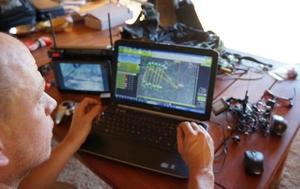DronesUniversity of Maryland opens new drone test facility
The University of Maryland has recently opened a new drone test site on the Eastern Shore which will allow researchers and students to help in the safe development of drones for use in U.S. airspace. The university will partner with companies to develop projects in a safe space. Already there are plans to use drones to monitor fish populations in the nearby Chesapeake Bay, examine power lines in the southern part of the state, and perform jobs which are considered “dirty, dull [or] dangerous,” in the words of the head of the facility.

University of Maryland launches drone test facility // Source: umd.edu
The University of Maryland has recently opened a new drone test site on the Eastern Shore which will allow researchers and students to help in the safe development of drones for use in U.S.s airspace.
TheBaltimore Sun reports that after years of planning and coordination, the facility is now open for business. Last Friday, the state Economic Development Secretary Dominick Murray called the potential of the project and the technology “unbelievable.”
“[It] will give industry a place to go,” said Matt Scassero, a former Navy pilot who is in charge of the facility.
Scassero’s statement comes against a backdrop of continuing controversy over the place and role of drones in the United States. Privacy groups are wary of drones being used by law enforcement, while others fear of privacy violations by prying media. The commercial aviation industry is concerned with safety issues in crowded skies.
Many, however, see the benefits of the technology — such as their use to deliver goods, monitor agricultural sites, and measure environmental conditions around the country.
The Maryland facility opens at a time when the Federal Aviation Administration (FAA) is supporting research into how drones may be safely used by private industry. With few exceptions, industry is currently not allowed to operate drones.
The university will partner with companies to develop projects in a safe space. Already there are plans to use drones to monitor fish populations in the nearby Chesapeake Bay, examine power lines in the southern part of the state, and perform jobs which are considered “dirty, dull [or] dangerous,” in Scassero’s words.
The university has already successfully launched its first drone last week, but there is still uncertainty about how much drone use will be allowed in the future. Congress has directed the FAA to develop policies and regulations for drone flight, Currently, each operation at the site require a separate FAA authorization.
The FAA, however, is considering an amendment which would allow for certain small drones to fly at lower altitudes, but the clearances for larger models is likely further away, probably beyond two years.
“With any revolutionary or disruptive technology it always outpaces the regulations,” said Michael Toscano, the head of an unnamed drone industry group, “You don’t write laws for things you don’t know about.”
At the University of Maryland, however, they are focusing on securing a successful flight, and on how these tests can benefit the state. After the successful flight of a radio-controlled propeller craft on Friday, the team loaded it up and returned it to the campus, a symbol of what the future may bring to the site.
